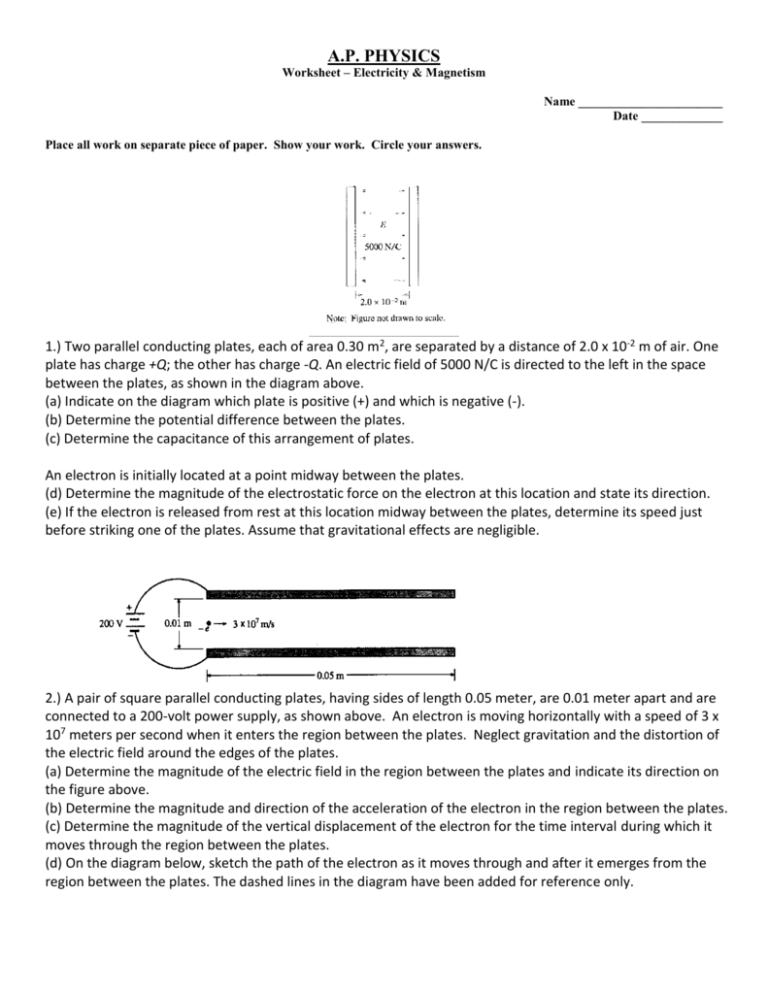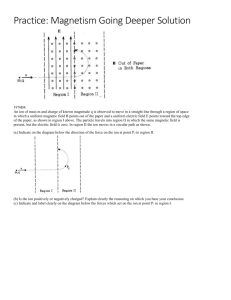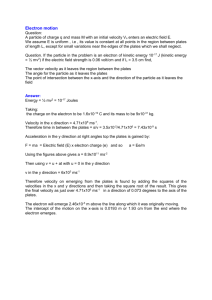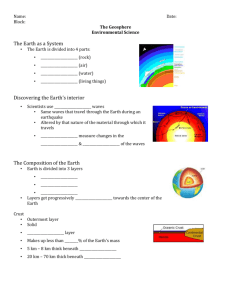ap physics - Cloudfront.net
advertisement

A.P. PHYSICS Worksheet – Electricity & Magnetism Name _______________________ Date _____________ Place all work on separate piece of paper. Show your work. Circle your answers. 1.) Two parallel conducting plates, each of area 0.30 m2, are separated by a distance of 2.0 x 10-2 m of air. One plate has charge +Q; the other has charge -Q. An electric field of 5000 N/C is directed to the left in the space between the plates, as shown in the diagram above. (a) Indicate on the diagram which plate is positive (+) and which is negative (-). (b) Determine the potential difference between the plates. (c) Determine the capacitance of this arrangement of plates. An electron is initially located at a point midway between the plates. (d) Determine the magnitude of the electrostatic force on the electron at this location and state its direction. (e) If the electron is released from rest at this location midway between the plates, determine its speed just before striking one of the plates. Assume that gravitational effects are negligible. 2.) A pair of square parallel conducting plates, having sides of length 0.05 meter, are 0.01 meter apart and are connected to a 200-volt power supply, as shown above. An electron is moving horizontally with a speed of 3 x 107 meters per second when it enters the region between the plates. Neglect gravitation and the distortion of the electric field around the edges of the plates. (a) Determine the magnitude of the electric field in the region between the plates and indicate its direction on the figure above. (b) Determine the magnitude and direction of the acceleration of the electron in the region between the plates. (c) Determine the magnitude of the vertical displacement of the electron for the time interval during which it moves through the region between the plates. (d) On the diagram below, sketch the path of the electron as it moves through and after it emerges from the region between the plates. The dashed lines in the diagram have been added for reference only. (e) A magnetic field could be placed in the region between the plates which would cause the electron to continue to travel horizontally in a straight line through the region between the plates. Determine both the magnitude and the direction of this magnetic field. 3.) A battery with an emf of 24 volts and an internal resistance of I ohm is connected to an external circuit as shown above. Determine each of the following: (a) the equivalent resistance of the combination of the 4-ohm, 8-ohm, and 12-ohm resistors (b) the current in the 5-ohm resistor (c) the terminal voltage, VAC of the battery (d) the rate at which energy is dissipated in the 12-ohm resistor (e) the magnitude of the potential difference VBC (f) the power delivered by the battery to the external circuit 4.) The magnitude of the magnetic field in teslas at a distance d from a long straight wire carrying a current I is given by the relation B = 2 X 10-7 I/d. The two long straight wires shown above are perpendicular, insulated from each other, and small enough so that they may be considered to be in the same plane. The wires are not free to move. Point P, in the same plane as the wires, is 0.5 meter from the wire carrying a current of 1 ampere and is 1.0 meter from the wire carrying a current of 3 amperes. (a) What is the direction of the net magnetic field at P due to the currents? (b) Determine the magnitude of the net magnetic field at P due to the currents. A charged particle at point P that is instantaneously moving with a velocity of 10 6 meters per second toward the top of the page experiences a force of 10-7 newtons to the left due to the two currents. (c) State whether the charge on the particle is positive or negative. (d) Determine the magnitude of the charge on the particle. (e) Determine the magnitude and direction of an electric field also at point P that would make the net force on this moving charge equal to zero. 5.) An electron initially moves in a horizontal direction and has a kinetic energy of 2.0 x 10 3 electron-volts when it is in the position shown above. It passes through a uniform electric field between two oppositely charged horizontal plates (region I) and a field-free region (region II) before eventually striking a screen at a distance of 0.08 meter from the edge of the plates. The plates are 0.04 meter long and are separated from each other by a distance of 0.02 meter. The potential difference across the plates is 250 volts. Gravity is negligible. (a) Calculate the initial speed of the electron as it enters region I. (b) Calculate the magnitude of the electric field E between the plates, and indicate its direction on the diagram above. (c) Calculate the magnitude of the electric force F acting on the electron while it is in region I. (d) On the diagram below, sketch the path of the electron in regions I and II. For each region describe the shape of the path. 6.) A rail gun is a device that propels a projectile using a magnetic force. A simplified diagram of this device is shown above. The projectile in the picture is a bar of mass M and length D, which has a constant current I flowing through it in the +y-direction, as shown. The space between the thin frictionless rails contains a uniform magnetic field B, perpendicular to the plane of the page. The magnetic field and rails extend for a distance L. The magnetic field exerts a constant force F on the projectile, as shown. Express all algebraic answers to the following parts in terms of the magnitude F of the constant magnetic force, other quantities given above, and fundamental constants. a. Determine the position x of the projectile as a function of time t while it is on the rail if the projectile starts from rest at x = 0 when t = 0. b. Determine the speed of the projectile as it leaves the right-hand end of the track. c. Determine the energy supplied to the projectile by the rail gun. d. In what direction must the magnetic field B point in order to create the force F ? Explain your reasoning. e. Calculate the speed of the bar when it reaches the end of the rail given the following values. B=5T L=l0m 1=200A M=0.5 kg D=l0cm








